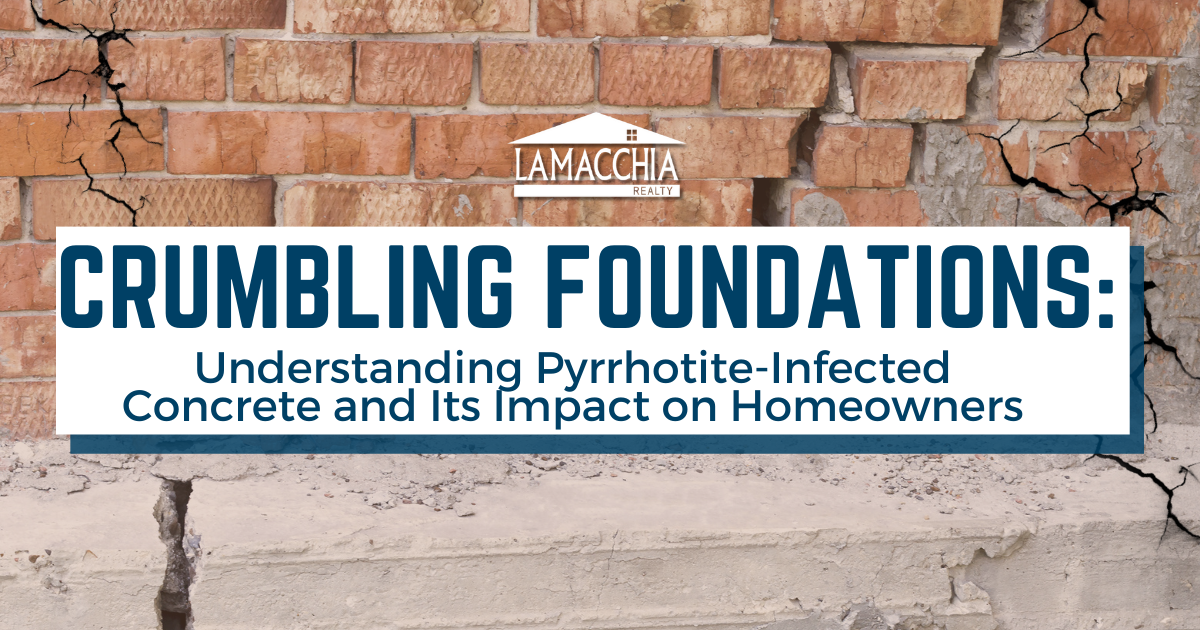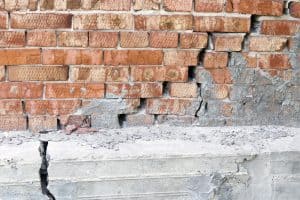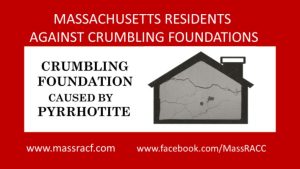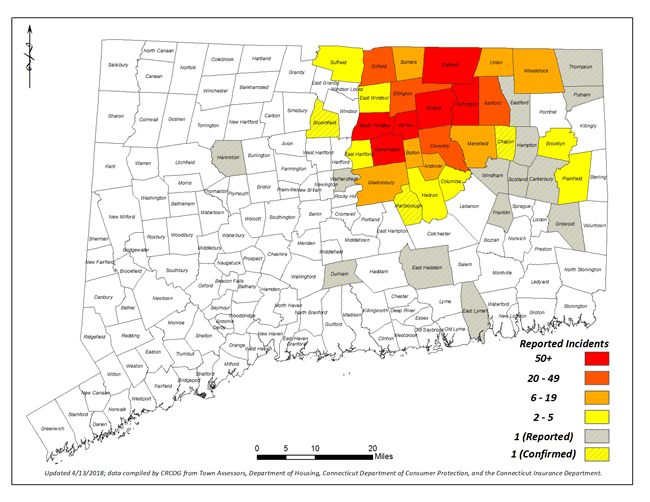
Crumbling foundations – This is an epidemic affecting thousands of homeowners throughout Western Massachusetts and Northeastern Connecticut. A significant number of homes in these areas built between 1983-2015 may have concrete foundations containing pyrrhotite, which means they’re at risk of cracking or even crumbling completely. This is understandably alarming to homeowners whose properties fit these criteria, fearing for the safety of their families and their investments. Many residents have been affected by this crisis already and are working to gain support from their community and local government. However, hope may be on the horizon, as two new bills aiming to prevent the use of contaminated concrete and assist people in paying for their crumbling foundation repairs are currently being considered.
Understanding Concrete Foundations with Pyrrhotite
So, why should we care about pyrrhotite so much? Pyrrhotite is a mineral that ended up in certain batches of concrete originating from a cement quarry in Connecticut, and possibly more! These batches were used in thousands of foundations for new construction homes. After about 15-20 years, pyrrhotite naturally begins to expand and break apart due to exposure to water and air. There have already been several instances of pyrrhotite-infected foundations cracking and crumbling, putting both the property its and occupants at risk.
A Challenging Repair
The only solution for repairing the contaminated concrete is to completely replace the foundation, which can cost hundreds of thousands of dollars. To add insult to injury, insurance doesn’t cover it. This process would involve physically lifting the property off its existing foundation, and then replacing all the concrete underneath. People may often say that no price is too high to ensure the safety of their families, but when the cost of repair is almost equal to the value of the entire home, this just isn’t feasible for many. With this project being both expensive and timely, it would literally and figuratively uproot many lives.
What Pyrrhotite-Infected Foundations Mean for Homeowners
 As home buyers and sellers are trying to navigate this already unique real estate market, the crumbling foundation crisis is an added stressor for those trying to buy and sell properties in these areas.
As home buyers and sellers are trying to navigate this already unique real estate market, the crumbling foundation crisis is an added stressor for those trying to buy and sell properties in these areas.
For home sellers, the discovery of a pyrrhotite-infected foundation can be devastating. It significantly diminishes the market value of the property and can make it extremely difficult to sell the home. Potential buyers are often hesitant to invest in a property with a known foundation issue, as it implies costly repairs and potential safety concerns. The presence of pyrrhotite may even turn some buyers away from considering the property altogether, reducing the number of potential purchasers and prolonging the time it takes to sell the house. As a result, home sellers with pyrrhotite-infected foundations may have to decrease their asking price significantly, or the property could remain on the market for an extended period.
On the other hand, home buyers also face challenges when dealing with a property affected by pyrrhotite. As covered in JoAnn Demorse’s case, repairing or replacing a cracked foundation can potentially cost hundreds of thousands of dollars. Buyers may need to factor these costs into their budget and negotiation process when considering purchasing a home with a pyrrhotite-infected foundation. Additionally, the repair process can be time-consuming and disruptive, requiring the homeowners to vacate the property during construction. Additionally, buyers may need to consider the long-term problems that could arise even after the foundation has been repaired, as there could be ongoing foundation maintenance for years to come.
Awareness of these challenges is essential for both buyers and sellers to effectively progress through the current real estate market and make informed decisions when dealing with properties affected by pyrrhotite-infected foundations. By talking with an expert Lamacchia Realty REALTOR®, potential buyers and sellers will have an expert in their corner to guide them through these troubling times.
Initiatives and Solutions to Address Crumbling Foundations
As more and more homeowners across these states discover the devastating effects of pyrrhotite on their properties, a sense of urgency has filled communities. In the face of this rapidly growing problem, proactive measures are being taken to address the issue and provide relief to affected homeowners. In both Massachusetts and Connecticut, initiatives are underway to tackle the pyrrhotite crisis head-on, aiming to alleviate the financial burden and provide support to those impacted.
Massachusetts Initiatives
There is a glimmer of hope for Massachusetts homeowners, as two new bills have been introduced to remediate the crumbling foundation devastation. The first bill will require cement quarries to test all of their concrete for pyrrhotite. If a batch contains any traces of the mineral, it cannot be used for the building of home foundations. The second bill will provide financial relief for homeowners looking to replace or repair their foundations. At this time, where the funding will come from has not been determined. In addition, a recent update on this bill introduced an amendment that would require insurance to cover this cost if they denied crumbling foundation claims between 2000-2021.
 Over the last several years, a group called Massachusetts Residents Against Crumbling Foundations has been fighting for government support to alleviate this nightmare. The group is actively spreading awareness online, speaking at local events, and providing testimonies to push the pending bills at The Joint Committee on Environment and Natural Resources hearing, most recently on April 10th, 2023. For more information on Massachusetts Residents Against Crumbling Foundations, you can visit their website at www.massracf.com.
Over the last several years, a group called Massachusetts Residents Against Crumbling Foundations has been fighting for government support to alleviate this nightmare. The group is actively spreading awareness online, speaking at local events, and providing testimonies to push the pending bills at The Joint Committee on Environment and Natural Resources hearing, most recently on April 10th, 2023. For more information on Massachusetts Residents Against Crumbling Foundations, you can visit their website at www.massracf.com.
Connecticut Initiatives
Connecticut has already taken action and has passed several bills to resolve this nightmare. These bills cover all sorts of aspects from concrete testing to financial compensation. This includes Public Act 18-179, Public Act 18-160, Public Act 17-2, and Public Act 16-45 which can be summarized in the images below:
For more information on Connecticut’s government programs for crumbling foundations, click here.
Recent Case of a Pyrrhotite-Infected Foundation
Many Massachusetts and Connecticut residents have already suffered from this nightmare, including JoAnn Demore of Rutland, MA. In an interview with WCVB News, Demorse describes her home as a “ticking time bomb”, as her basement walls are covered in cracks that are continuing to grow larger and beginning to flake. Even though the property is only about 20 years old, engineers have warned Demorse that the foundation will collapse within a few years. Unfortunately, this has left her with a home that’s unable to sell unless she makes the $200,000 repair.
“It’s all the equity. Everything,” she said. “It’s everything you worked for.” –JoAnn Demorse, Interviewing for WCVB News
Demorse is not the only homeowner who has been affected by this rapidly growing problem. Below is a map from The Reminder, a newspaper out of Monson, MA, of known Massachusetts towns affected by pyrrhotite-tainted foundations and crumbling.
Source: The Reminder.com
Connecticut homes are also extremely affected. The Capitol Region Council of Governments (CRCOG) have identified several towns in northeastern Connecticut that have been impacted by crumbling foundations. As you can see if their map below, many towns have over 50 reported incidents.
The widespread issue of crumbling foundations caused by pyrrhotite contamination in Western Massachusetts and Northeastern Connecticut is an ongoing concern for homeowners. The potential risks to safety and property value have led to a sense of urgency within affected communities. The high cost and complicated repairs create a challenging situation for homeowners, with insurance typically not covering the expenses. Home sellers face difficulty finding buyers, and potential buyers must consider the financial and long-term maintenance of purchasing a property with a pyrrhotite-infected foundation.
However, there are glimmers of hope as initiatives and bills are being introduced in both Massachusetts and Connecticut to address the crisis. These initiatives aim to prevent the use of contaminated concrete and provide financial relief for homeowners. Communities are actively raising awareness and advocating for government support to alleviate the devastating impact of crumbling foundations. Through these initiatives and the efforts of residents, there is optimism that the devastating impact of crumbling foundations caused by pyrrhotite contamination will be addressed, providing relief and support to those in need.


